Eruptions of Telica and Momotombo prompt emergency preparations in Nicaragua
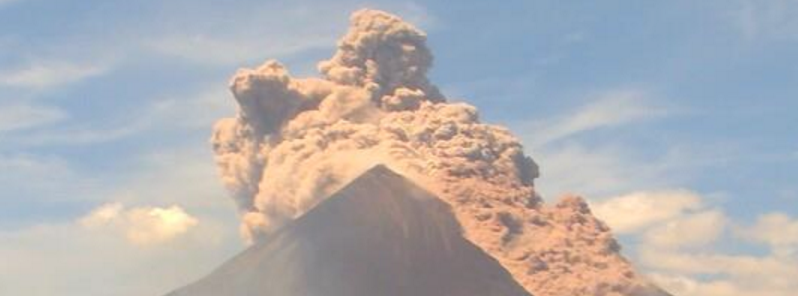
Both Momotombo and Telica volcanoes in Nicaragua reported explosions on February 13, 2016. In response, the local authorities activated emergency plans to provide a rapid response if the communities become threatened. No injuries have been reported, but several communities experienced ashfall from the explosions.
A series of approximately 12 small explosions occurred at Telica volcano on the morning of February 13 (local time). INETER reported ash columns rising between 300 and 1 000 m (984 and 3 281 feet) above the crater. At least 20 smaller eruptions were recorded in the next couple of hours. Some local communities experienced ashfall.
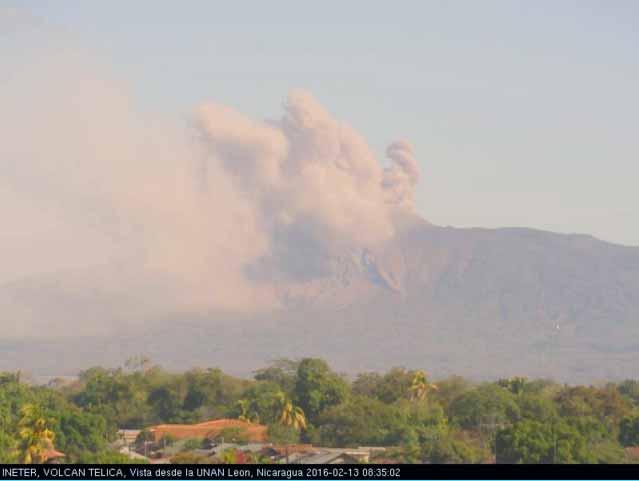
Telica volcano eruption, February 13, 2016, 08:35 (local time). Image credit: INETER
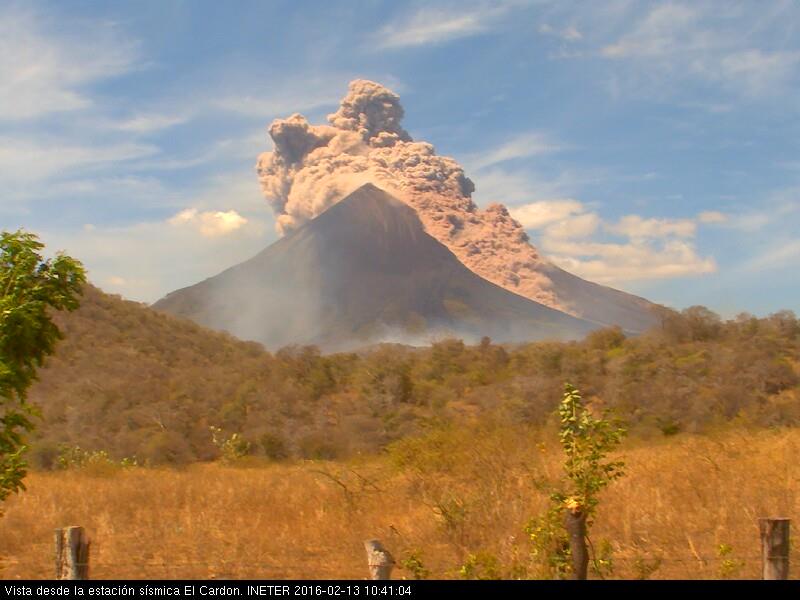
Momotombo volcano eruption, February 13, 2016, 10:41 (local time). Image credit: INETER
Momotombo volcano exploded shortly after Telica's first eruption. The explosion occurred at 10:40 (local time), producing a pyroclastic flow that descended on the NE flank. The pyroclastic flow, surrounded by yellow-brown ash, was thought to result from the collapse of older material at the crater during the explosion. The glow was visible at the crater throughout the night, meaning that temperatures remained increased.
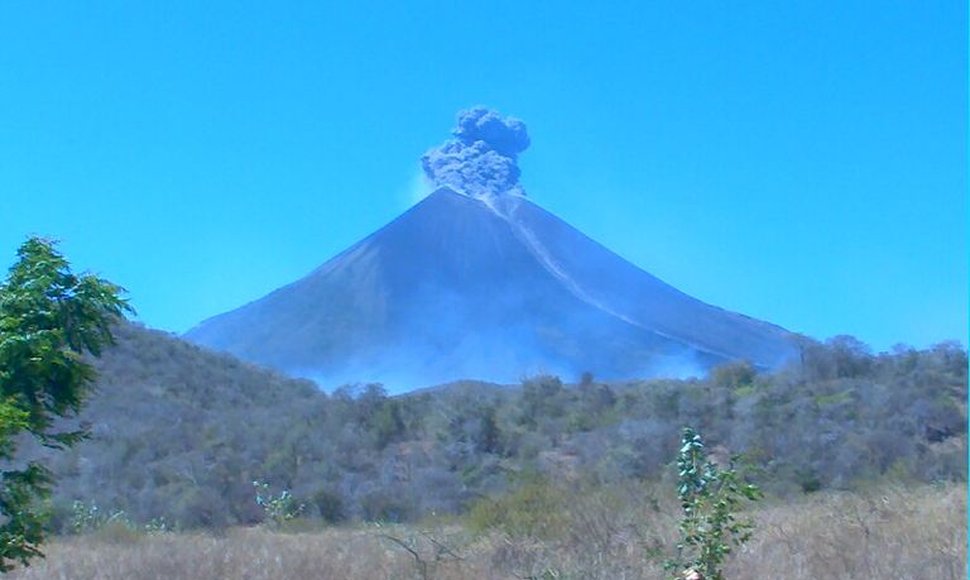
Momotombo volcano, February 12, 2016. Image credit: INETER
Two relatively small explosions occurred at the Momotombo volcano on February 12, around 02:20 and 11:15 (local time). Incandescent material was ejected onto the upper flank of the cone and produced ash plumes that quickly dissipated into westerly directions, Volcano Discovery reports.
INETER reports the activity was accompanied by a threefold increase in volcanic tremor and preceded by a significant increase in SO2 output from approximately 600 to over 1 000 tons per day, in the period between February 9 and 11. Eruptions most likely resulted from a new magma batch rising inside the volcano.
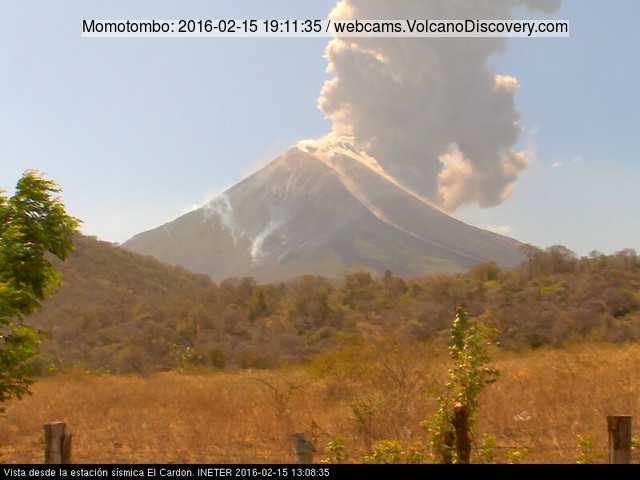
Momotombo volcano eruption on February 15, 2016. Image credit: INETER
 Momotombo volcano, crater glow and bush fires from volcanic bombs on the morning of February 16, 2015, after eruptions occurred a day earlier. Image credit: INETER
Momotombo volcano, crater glow and bush fires from volcanic bombs on the morning of February 16, 2015, after eruptions occurred a day earlier. Image credit: INETER
Another moderately strong explosion was reported from the summit crater on February 15 at 13:08 (local time), ejecting an ash plume that rose approximately 1 000 m (3 280.8 feet). Many incandescent bombs that ignited bush fires on the upper flank of the volcano were observed. Bright glow at the crater at night indicates the presence of new magma.
Four 5 minute long explosions, generating ash-and-ash emission were detected at Telica at 06:02, 08:18, 09:34 and 11:24 on November 25, 2015 (local time), according to GVP. Multiple gas-and-ash explosions were observed during November 26, the strongest of which occurred at 09:41, producing an ash plume rising 800 m (2 624.7 feet) above the crater. 29 explosions were reported between November 26 and 27, 16 of which produced ash plumes.
A strong explosion at 12:10 (local time) sent an ash plume about 3 km (9 842.5 feet) from the volcano summit and generated a small pyroclastic flow.
After 110 years of being dormant, Momotombo volcano awakened on the morning of December 1, 2015. Four eruptions were recorded on the occasion sending steam and ash plumes up to 1 km (3 281 feet) above the volcano summit.
No injuries were reported from the most recent events. However, the Civil Defense of Nicaragua activated emergency plans to provide a rapid response in case the communities become at risk. They have also visited communities near the Momotombo volcano to coordinate evacuation routes in case a major incident occurs.
Geological summary
Telica
Telica, one of Nicaragua's most active volcanoes, has erupted frequently since the beginning of the Spanish era. This volcano group consists of several interlocking cones and vents with a general NW alignment. Sixteenth-century eruptions were reported at symmetrical Santa Clara volcano at the SW end of the group. However, its eroded and breached crater has been covered by forests throughout historical time, and these eruptions may have originated from Telica, whose upper slopes, in contrast, are unvegetated.
The steep-sided cone of 1061-m-high (3 480.9 feet) Telica is truncated by a 700-m-wide (2 296.6 feet) double crater; the southern crater, the source of recent eruptions, is 120 m (393.7 feet) deep. El Liston, immediately SE of Telica, has several nested craters. The fumaroles and boiling mudpots of Hervideros de San Jacinto, SE of Telica, form a prominent geothermal area frequented by tourists, and geothermal exploration has occurred nearby.
Momotombo
Momotombo is a young, 1 297-m-high (4 255 feet) stratovolcano that rises prominently above the NW shore of Lake Managua, forming one of Nicaragua's most familiar landmarks. Momotombo began growing about 4500 years ago at the SE end of the Marrabios Range and consists of a somma from an older edifice that is surmounted by a symmetrical younger cone with a 150 x 250 m (492 x 820 feet) wide summit crater. Young lava flows from Momotombo have flowed down the NW flank into the 4-km-wide (2.5 miles) Monte Galán caldera.
The youthful cone of Momotombito forms a 391-m-high (1 282.8 feet) island offshore in Lake Managua. Momotombo has a long record of strombolian eruptions, punctuated by occasional larger explosive activity. The latest eruption, in 1905, produced a lava flow that traveled from the summit to the lower NE base. A small black plume was seen above the crater after an April 10, 1996, earthquake, but later observations noted no significant changes in the crater. A major geothermal field is located on the southern flank of the volcano. (GVP)
Featured image: Momotombo eruption, February 13, 2016. Image credit: INETER

Commenting rules and guidelines
We value the thoughts and opinions of our readers and welcome healthy discussions on our website. In order to maintain a respectful and positive community, we ask that all commenters follow these rules:
We reserve the right to remove any comments that violate these rules. By commenting on our website, you agree to abide by these guidelines. Thank you for helping to create a positive and welcoming environment for all.